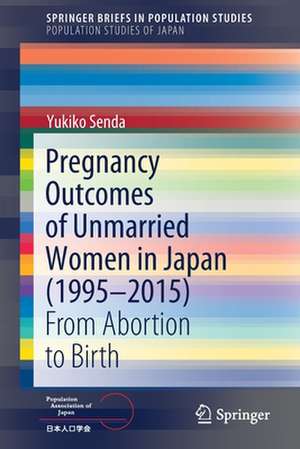Pregnancy Outcomes of Unmarried Women in Japan (1995–2015): From Abortion to Birth: SpringerBriefs in Population Studies
Autor Yukiko Sendaen Limba Engleză Paperback – 28 aug 2021
Previously, it was believed that the idea of a ‘second demographic transition’ did not apply to Japan, which had a relatively low rate of extra-marital fertility. However, more recently, though still at a low level, a subtle but gradual rise is seen in the number of women who become unmarried mothers as a result of births outside marriage.
This trend suggests that the social environment surrounding pregnancy, childbirth, and marriage is changing. In this book, various data such as national statistics, nationwide surveys, and media discourse are analysed with a view torevealing the factors affecting unmarried women’s decisions when they discover they are pregnant. Various matters are discussed, such as changes in sexual activity and contraceptive use, advance in reproductive technology, the law and government policies pertaining to adoption, social consciousness towards unwed mothers, the change in perception of abortion from the religious perspective, and difference of socioeconomic status depending on the women’s occupation.
Facts from vital statistics are first laid out, showing that, while abortion has consistently been on the decrease from the 1990s onward, shotgun marriages have peaked out. Adoption is rare and remains very small in proportion, while extra-marital fertility is on the rise. The author then points to the possibility that greater lenience found in the social consciousness towards unwed mothers in recent years is a pull factor for the increase in extra-marital fertility. Further, by analysing vital statistics, it is revealed that the probability of becoming a mother without marrying changed with the woman’s occupation, explicable by the stability of employment and level of income, and that between 1995 and 2015, the effects of the job factor are changing. If we assume that, unlike the first demographic transition model, the ‘second demographic transition’ may show a similar direction but be on a different scale according to the country, it is possible to say that Japan too is experiencing the ‘second demographic transition’.
Din seria SpringerBriefs in Population Studies
-
 Preț: 344.90 lei
Preț: 344.90 lei -
 Preț: 177.49 lei
Preț: 177.49 lei -
 Preț: 355.53 lei
Preț: 355.53 lei -
 Preț: 317.19 lei
Preț: 317.19 lei -
 Preț: 442.62 lei
Preț: 442.62 lei - 15%
 Preț: 463.03 lei
Preț: 463.03 lei - 15%
 Preț: 463.68 lei
Preț: 463.68 lei -
 Preț: 377.57 lei
Preț: 377.57 lei -
 Preț: 414.42 lei
Preț: 414.42 lei -
 Preț: 476.57 lei
Preț: 476.57 lei -
 Preț: 376.80 lei
Preț: 376.80 lei -
 Preț: 376.22 lei
Preț: 376.22 lei -
 Preț: 377.73 lei
Preț: 377.73 lei -
 Preț: 379.09 lei
Preț: 379.09 lei -
 Preț: 346.66 lei
Preț: 346.66 lei -
 Preț: 380.07 lei
Preț: 380.07 lei -
 Preț: 343.88 lei
Preț: 343.88 lei -
 Preț: 374.46 lei
Preț: 374.46 lei -
 Preț: 343.39 lei
Preț: 343.39 lei -
 Preț: 205.29 lei
Preț: 205.29 lei -
 Preț: 378.92 lei
Preț: 378.92 lei -
 Preț: 375.23 lei
Preț: 375.23 lei -
 Preț: 378.34 lei
Preț: 378.34 lei -
 Preț: 474.84 lei
Preț: 474.84 lei -
 Preț: 476.42 lei
Preț: 476.42 lei -
 Preț: 379.09 lei
Preț: 379.09 lei -
 Preț: 476.79 lei
Preț: 476.79 lei -
 Preț: 441.85 lei
Preț: 441.85 lei - 15%
 Preț: 461.73 lei
Preț: 461.73 lei -
 Preț: 375.23 lei
Preț: 375.23 lei -
 Preț: 259.96 lei
Preț: 259.96 lei -
 Preț: 343.88 lei
Preț: 343.88 lei -
 Preț: 442.62 lei
Preț: 442.62 lei -
 Preț: 474.67 lei
Preț: 474.67 lei -
 Preț: 443.75 lei
Preț: 443.75 lei -
 Preț: 443.00 lei
Preț: 443.00 lei -
 Preț: 262.09 lei
Preț: 262.09 lei -
 Preț: 376.80 lei
Preț: 376.80 lei -
 Preț: 377.18 lei
Preț: 377.18 lei -
 Preț: 311.91 lei
Preț: 311.91 lei -
 Preț: 376.59 lei
Preț: 376.59 lei -
 Preț: 174.62 lei
Preț: 174.62 lei -
 Preț: 379.09 lei
Preț: 379.09 lei -
 Preț: 477.72 lei
Preț: 477.72 lei -
 Preț: 340.45 lei
Preț: 340.45 lei -
 Preț: 374.85 lei
Preț: 374.85 lei -
 Preț: 475.22 lei
Preț: 475.22 lei
Preț: 477.17 lei
Nou
Puncte Express: 716
Preț estimativ în valută:
91.30€ • 95.59$ • 75.55£
91.30€ • 95.59$ • 75.55£
Carte tipărită la comandă
Livrare economică 05-19 aprilie
Preluare comenzi: 021 569.72.76
Specificații
ISBN-13: 9789811635489
ISBN-10: 981163548X
Pagini: 101
Ilustrații: X, 101 p. 39 illus., 38 illus. in color.
Dimensiuni: 155 x 235 mm
Greutate: 0.17 kg
Ediția:1st ed. 2021
Editura: Springer Nature Singapore
Colecția Springer
Seriile SpringerBriefs in Population Studies, Population Studies of Japan
Locul publicării:Singapore, Singapore
ISBN-10: 981163548X
Pagini: 101
Ilustrații: X, 101 p. 39 illus., 38 illus. in color.
Dimensiuni: 155 x 235 mm
Greutate: 0.17 kg
Ediția:1st ed. 2021
Editura: Springer Nature Singapore
Colecția Springer
Seriile SpringerBriefs in Population Studies, Population Studies of Japan
Locul publicării:Singapore, Singapore
Cuprins
Introduction.- 1. Trend of Pregnancy Ontcome and Its Social Background in Japan after WWII.- 2. Theory of Socioeconomic Disparities.- 3. Report of Vital Statistics: Occupational and Industrial Aspects.- 4. Pregnancy Outcome I : Sponteneous Abortoin .- 5. Pregnancy Outcome II : Artificial Abortoin.- 6. Pregnancy Outcome III : Infant Death.- 7. Pregnancy Outcome IV : Infant Survival.-Conclusion.
Notă biografică
Yukiko Senda, Tohoku Gakuin University, Department of Liberal Arts
Caracteristici
Reveals the latest trends in pregnancy outcome in Japan, utilizing complete vital statistics data for the first time Explains how socioeconomic factors affect spontaneous or artificial abortion, infant death, and infant survival Bridges the two disciplines of population studies and social epidemiology
